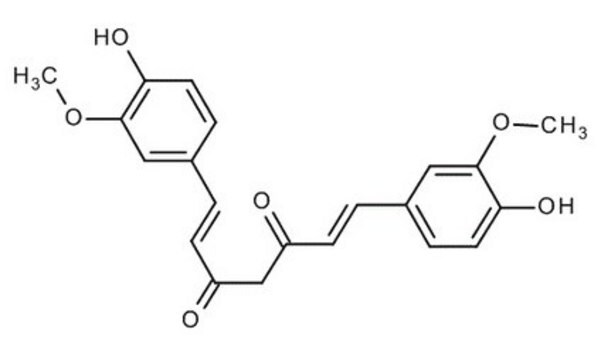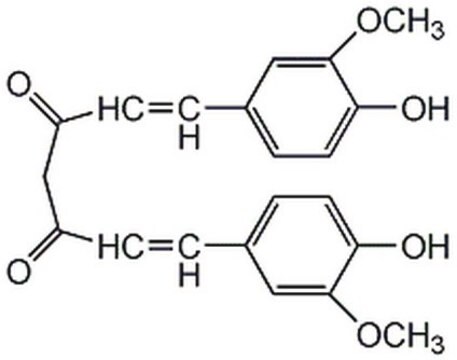C7727
Curcumin
≥94% (curcuminoid content), ≥80% (Curcumin)
Synonym(s):
(E,E)-1,7-bis(4-Hydroxy-3-methoxyphenyl)-1,6-heptadiene-3,5-dione, Diferuloylmethane, Diferulylmethane, Natural Yellow 3
About This Item
Recommended Products
vapor density
13 (vs air)
Quality Level
Assay
≥80% (Curcumin)
≥94% (curcuminoid content)
form
powder
mp
175 °C
solubility
ethanol: 1 mg/mL
DMSO: >11 mg/mL
0.5 M NaOH: soluble (then immediately diluted in PBS)
application(s)
metabolomics
vitamins, nutraceuticals, and natural products
storage temp.
−20°C
SMILES string
COc1cc(\C=C\C(=O)CC(=O)\C=C\c2ccc(O)c(OC)c2)ccc1O
InChI
1S/C21H20O6/c1-26-20-11-14(5-9-18(20)24)3-7-16(22)13-17(23)8-4-15-6-10-19(25)21(12-15)27-2/h3-12,24-25H,13H2,1-2H3/b7-3+,8-4+
InChI key
VFLDPWHFBUODDF-FCXRPNKRSA-N
Gene Information
human ... APP(351) , CYP1A2(1544)
Looking for similar products? Visit Product Comparison Guide
Related Categories
General description
Application
- to study its in vitro effect on the inflammation and expression of tumour factor in patients with chronic kidney diseases
- to determine its influence when used in combination with high frequency ultrasound on human cervical carcinoma cells
- to study the possibility of using magnetic purification of curcumin from Curcuma longa by surface active maghemite nanoparticles (SAMNs)
- to examine its effect on the amyloid-β peptide levels along with the maturation of amyloid-β precursor proteins in various cell lines and primary cortical neurons in mouse
- as a supplement to evaluate its anti-carcinogenic and anti-apoptotic effect on cancer cells and cardiomyocytes
- to test its anti-inflammatory effect in human promyelocytic leukemia cell line, the HL-60
Biochem/physiol Actions
Storage Class Code
11 - Combustible Solids
WGK
WGK 3
Flash Point(F)
Not applicable
Flash Point(C)
Not applicable
Choose from one of the most recent versions:
Already Own This Product?
Find documentation for the products that you have recently purchased in the Document Library.
Customers Also Viewed
Our team of scientists has experience in all areas of research including Life Science, Material Science, Chemical Synthesis, Chromatography, Analytical and many others.
Contact Technical Service





